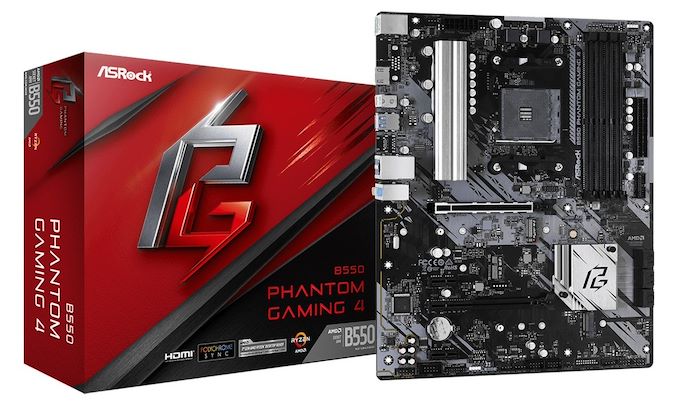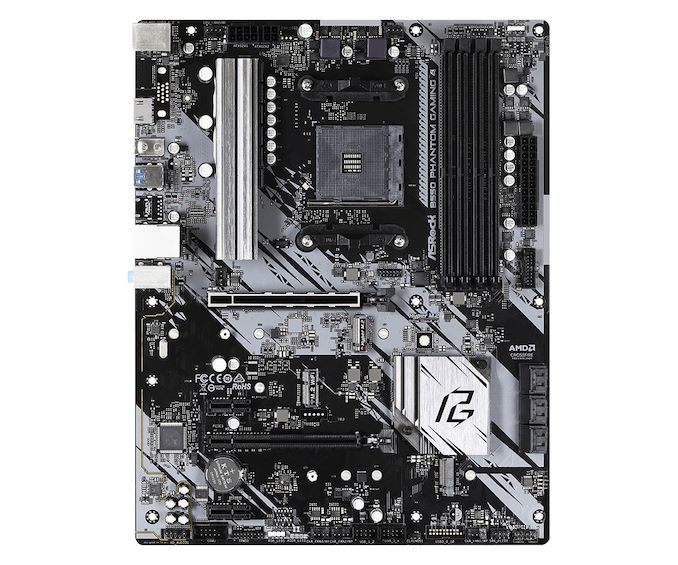The AMD B550 Motherboard Overview: ASUS, GIGABYTE, MSI, ASRock, and Others
by Dr. Ian Cutress & Gavin Bonshor on June 16, 2020 11:00 AM ESTASRock B550 Phantom Gaming 4 + 4ac
For this segment, we’re covering two motherboards: the ASRock B550 Phantom Gaming 4, and the ASRock B550 Phantom Gaming 4ac. The difference between the two, you would think given the name, is that the AC model has Wi-Fi 5 installed. There is another subtle difference, in that the standard PG4 has six SATA ports, whereas the PG4ac model only has four. This is despite both models still having the same PCIe layout, so we’re unsure why there is a difference. Nonetheless the rest of the boards are the same.
As we move to the cheaper end of the B550 range, we move to the motherboards that do not have rear-IO covers, and more limited power delivery and chipset cooling. Despite the PG4 box being red, the board itself is a lot more silver, playing into the Phantom Gaming theme, but with fewer heatsinks there is less to actually cover. For the power delivery here, for example, there is a single heatsink on the left hand side where all six phases for the CPU are. The chipset heatsink is a lot smaller, and neither of the M.2 slots have heatsinks either.
The CPU is powered by an 8-pin and a 4-pin, and the socket area has easy access to three 4-pin fan headers as needed. The motherboard still has a full complement of DDR4 slots, and these are single sided latch variants.
On the right hand side of the motherboard there is a USB 3.0 header, SATA ports, but no power/reset buttons. On the bottom there is an audio header, a COM header, a TPM header, RGB LED headers, three more 4-pin fan headers, two USB 2.0 headers, and a front panel header.
The PCIe layout puts a full PCIe 4.0 x16 slot at the top with additional reinforcement, directly above the PCIe 4.0 x4 M.2 slot for storage. There is an M.2 Wi-Fi slot underneath this, which with the PG4ac is filled with an Intel AC3168 1x1 solution, one of the cheapest 802.11ac modules you can get. There is a full length PCIe 3.0 x4 slot from the chipset, and underneath this is another M.2 slot, this time PCIe 3.0 x2 from the chipset.
The audio section on the right hand side is using an upgraded ALC1200 audio codec, with PCB separation and filter caps. Unlike the other ALC1200 variants we’ve seen from ASRock, this board only has three audio outputs.
On the rear panel we have a combination PS/2 port, six USB 3.2 Gen 1 ports, a HDMI output, and a single Realtek RTL8111H gigabit Ethernet port. There are no USB 3.2 Gen 2 ports on this motherboard.













101 Comments
View All Comments
Savikid - Tuesday, August 25, 2020 - link
But the new oculus stuff only uses 1 usb port, so that right there is a drop. I use 2 for keyboard and mouse, one for a wireless controller, and one for my HMD.Gigaplex - Tuesday, June 16, 2020 - link
"On that one I added a USB PCI card to get enough ports."That's not really helpful to the user who said they can't add in a card on their mITX system.
eye4bear - Wednesday, July 1, 2020 - link
Must be nice to have no external hard-drives, I have 3 all needing their own USB 3 port, along with a Logitech dongle that runs both my mouse and keyboard, finally a Bluethooth dongle as my computer has none built-in. Yes I would need 6 USB ports (one open for USB sticks) just to keep even.consolessuck - Friday, November 6, 2020 - link
No, I have 3 usb ports on my laptop and i only use 1 for my mouse. As it turns out, the most amount of usb ports i use at once is two when i am making a wired data transfer with my mouse plugged in. Actually, I almost never transfer data to my phone with a wire, instead just sharing them via bluetooth. and considering i never make large data transfers to my phone, this works out just fine. as for a desktop, however, i'd like a minimum of 3 as i'll always have not only a mouse, but a keyboard plugged in all the time.taz-nz - Thursday, June 18, 2020 - link
The Asrock B550M Steel Legend has 8 port on the back:4x USB-A 3.1 ports
1x USB-A 3.2 port
1x USB-C 3.2 port
2x USB-A 2.0 ports
And you still have two USB 2.0 internal header, plus two USB 3.1 internal headers.
So that allows you to have another
4x USB-A 3.1
4x USB-A 2.0 ports.
so that's 16 Ports
Now if you like me and need Internal USB 3.2 USB-C header, you can use the PCIe 3.0 x2 m.2 slot to add one of these:
https://www.delock.de/produkte/S_63998/merkmale.ht...
or if you want two more USB 3.1 internal header you could add one of these:
https://www.delock.de/produkte/G_62843/merkmale.ht...
So if you can live without a second m.2 slot you have four more USB-A 3.0 ports.
That gives you 20 USB ports without giving up a PCIe slot.
taz-nz - Thursday, June 18, 2020 - link
oops, just noticed you said mITX not mATXdesii - Tuesday, June 16, 2020 - link
Do any of these motherboards support ECC RAM (either buffered or unbuffered)?drSeehas - Wednesday, June 17, 2020 - link
Socket AM4 CPUs support only unbuffered RAM.PixyMisa - Wednesday, June 17, 2020 - link
I did a quick look on ASRock's site, since they're pretty good on ECC support, and every B550 board I checked lists ECC as supported.Samus - Tuesday, June 16, 2020 - link
I think AMD screwed up here with pricing their platforms appropriately. I understand the push for PCIe 4 but they can't have average motherboard prices hovering between $200-$300. There has to be $100 motherboards to be taken seriously especially by OEM's if they want 4000 parts to become mainstream.But maybe they don't...maybe they plan to milk the 3000 parts for a few years. After all, there isn't much reason not too. They have no competition from Intel in the budget segment right now.